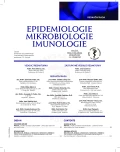The incidence of viral hepatitis A in the Hradec Králové Region in the Czech Republic in the last decade
Authors:
R. Šošovičková 1; J. Smetana 1; E. Beranová 2; K. Kučerová 2; R. Chlíbek 1
Authors‘ workplace:
Katedra epidemiologie, Fakulta vojenského zdravotnictví UO, Hradec Králové
1; Krajská hygienická stanice Královéhradeckého kraje se sídlem v Hradci Králové
2
Published in:
Epidemiol. Mikrobiol. Imunol. 65, 2016, č. 3, s. 164-170
Category:
Original Papers
Overview
Objective:
Viral hepatitis A continues to occur in the Czech Republic due to the high susceptibility of the population and existing opportunities for the transmission of the disease. The aim was to describe and analyse the incidence of viral hepatitis A in the Hradec Králové Region in the Czech Republic in 2005–2014, including the study of two outbreaks that required a different approach of field epidemiologists.
Material and Methods:
In 2015, a retrospective analysis was carried out of the data on the incidence of viral hepatitis A in Hradec Králové Region in 2005–2014. The EPIDAT system where cases of infectious diseases and data from epidemiological investigations are reported was used as a data source for the purposes of the present analysis. In addition, two final reports on epidemic outbreaks of viral hepatitis A from 2014 were assessed.
Results:
The incidence of viral hepatitis A at the regional level follows, to a certain extent, the pattern of the incidence of this disease at the national level. The highest number of cases was reported in 2010 due to a country-wide epidemic. The most affected age groups were children, adolescents, and young adults. The incidence of viral hepatitis A in individual years has a significant effect on the emergence of local outbreaks.
Conclusion:
The incidence of viral hepatitis A in the Czech Republic has a fluctuating trend, at both the national and regional levels. The highest incidence of viral hepatitis A was observed in the younger and middle-age categories. The high susceptibility of these population groups suggests the importance of vaccination against viral hepatitis A that confers specific personal protection.
Key words:
viral hepatitis A – incidence – outbreak – Czech Republic
Sources
1. Husa P. Virové hepatitidy. Praha: Galen 2005.
2. Baert L., Debevere J., Uyttendaele M. The efficacy of preservation methods to inactivate foodborne viruses. International Journal of Food Microbiology, 2009 May;131(2–3):83–94.
3. Heymann D. Control of Communicable Diseases Manual: Official Report of the American Public Health Association. 18th edition, American Public Health Association Publications; 2008.
4. Koff RS. Hepatitis A. Lancet, 1988;351(9116):1643–1649.
5. Chlíbek R, Smetana J, Čečetková B. Současnost očkování proti virovým hepatitidám. Postgraduální medicína, 2009;11 (Příloha 6):55–62.
6. Hendrickx G, Vosters A, Van Damme P. Advances in hepatitis immunization (A, B, E): public health policy and novel vaccine delivery. Curr Opin Infect Dis, 2012;25(5):578–583.
7. Částková J, Beneš Č. Zvýšený výskyt virové hepatitidy A v České republice v roce 2008 – aktualizovaná informace. Zprávy EM, 2008;18(1):19–21.
8. Vybrané infekční nemoci v ČR v letech 2005–2014 – absolutně [online]. Státní zdravotní ústav. Dostupné na www: http://www.szu.cz/publikace/data/vybrane-infekcni-nemoci-v-cr-v-letech-2003-2012-absolutne.
9. EPIDAT. Státní zdravotní ústav.
10. Rožňovský L. Virové hepatitidy. Vakcinologie, 2014;8(2):74–82.
11. Beran J. Očkování před cestou do zahraničí. Postgraduální medicína, 2001;9:978-984.
12. Vybrané infekční nemoci v ČR v letech 2005–2014 – relativně [online]. Státní zdravotní ústav. Dostupné na www: http://www.szu.cz/publikace/data/vybrane-infekcni-nemoci-v-cr-v-letech-2003-2012-relativne.
13. 26. Steffen R. Risk of hepatitis A in travellers. Vaccine, 1992; 10:69–72.
14. WHO position paper on hepatitis A vaccines – June 2012. Wkly Epidemiol Rec, 2012;87(28/29):261-76. Dostupné na www: http://www.who.int/wer/2012/wer8728_29.pdf.
15. Gossner CM, Severi E, Danielsson N, et al. Changing hepatitis A epidemiology in the European Union: new challenges and opportunities. Euro Surveill, 2015;20(16):pii=21101. Dostupné na www: http://www.eurosurveillance.org/ViewArticle.aspx?ArticleId=21101.
16. Fournet N, Baas D, van Pelt W, et al. Another possible food-borne outbreak of hepatitis A in the Netherlands indicated by two closely related molecular sequences, July to October 2011. Euro Surveill, 2012;17(6):20079.
17. Gallot C, Grout L, Roque-Afonso AM et al. Hepatitis A associated with semidried tomatoes, France, 2010. Emerging Infectious Disease, 2011;17(3):556–557.
18. Petrignani M, Harms M, Verhoef L, et al. Update: A food-borne outbreak of hepatitis A in the Netherlands related to semi-dried tomatoes in oil, January-February 2010. Euro Surveill, 2010;15(20):195–172.
19. European Centre for Disease Prevention and Control. Outbreak of hepatitis A in EU/EAA countries – Second update. Stockholm: ECDC; 2014.
20. Robesyn E, De Schrijver K, Wollants E, et al. An outbreak of hepatitis A associated with the consuption of raw beef. Journal of Clinical Virology, 2009;44(3):207–210.
21. Montaño-Remacha C, Ricotta L, Alfonsi V, et al. Hepatitis A outbreak in Italy, 2013: a matched case–control study. Euro Surveill, 2014;19(37):pii=20906. Dostupné na www: http://www.eurosurveillance.org/ViewArticle.aspx?ArticleId=20906.
22. Guzman-Herrador B, Jensvoll L, Einöder-Moreno M, et al. Ongoing hepatitis A outbreak in Europe 2013 to 2014: imported berry mix cake suspected to be the source of infection in Norway. Euro Surveill, 2014;19(15):pii=20775. Dostupné na www: http://www.eurosurveillance.org/ViewArticle.aspx?ArticleId=20775.
23. Němeček V. Sérologický přehled ČR v roce 2001 – virová hepatitida A, B, C. Zprávy CEM, 2003;12(3),(Příloha 1):55c015059.
24. Criado SM et al. Prevalence of anti-HAV antibodies in different age groups in Spain. 15th ECCMID, Copenhagen.
25. European Centre for Disease Prevention and Control. Annual Epidemiological Report 2012. Reporting on 2010 surveillance data and 2011 epidemic intelligence data. Stockholm: ECDC; 2013.
Labels
Hygiene and epidemiology Medical virology Clinical microbiologyArticle was published in
Epidemiology, Microbiology, Immunology

2016 Issue 3
Most read in this issue
- Stenotrophomonas maltophilia as the cause of ventilator-associated pneumonia in a female patient with toxic epidermal necrolysis and Clostridium colitis: time for off-label tigecycline?
- Avidity of selected autoantibodies – usefulness of their determination for clinical purposes
-
The occurrence of Ixodes ricinus ticks and important tick-borne pathogens in areas with high tick-borne encephalitis prevalence in different altitudinal levels of the Czech Republic
Part II. Ixodes ricinus ticks and genospecies of Borrelia burgdorferi sensu lato complex - Effect of lipophosphonoxins on inhibition of bacterial colonization of bone cements
